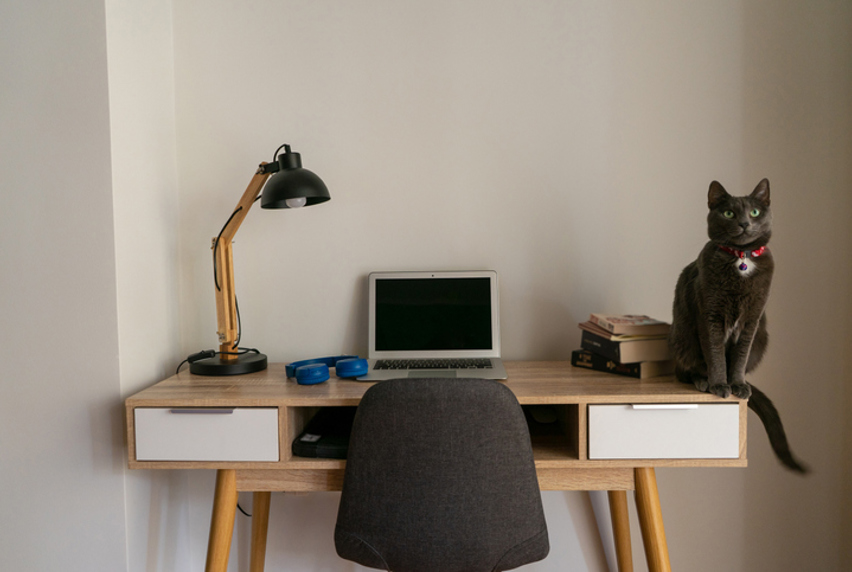Carving out a work space to call your own

As more and more of us start to work from home, we’ve pulled together some handy tips on what makes a great space to keep you productive.
First sort out the where. If you’re lucky enough to live in a house that has a designated room / study / home office, then you’re winning already. Even if you have to share this space with others you can personalise your spot and make it your own.
What works?
If not, like most of us, you going to need to have a good look around your home and take note of things like existing furniture, the people and the flow of energy. Who uses the space? how and when is it used? Where can you fit within that? You won’t need to splash the cash as you can make good use of what you already have, but you do need to be aware of what works for you.
Don’t mind a bit of action around you? Try a spot in the lounge or dining room. Need solitude? Maybe a bedroom. Do you need quiet but there isn’t any in your house? Headphones will be your best friend as they signal a silent ‘Do Not Disturb’ to your co-habitators.
Are you an eagle or a mouse?
The next step is to figure out exactly how much space is required. Your equipment needs will determine factors here; laptop, a text book or two, big drawings or multiple samples. Once you have determined this, figure out how you work - do you like to spread out your stuff or keep it compact? This will influence your choice of space, as will the timing of your studying. If you’re an early bird or a night owl, maybe you can spread out on the dining room table when no one else is around. Your study materials can be kept in a box or crate for easy access and a quick pack up.
The goal is to be comfortable, to want to be in the space you have chosen.
Make your stamp
Personalise it with an inspo board full of photos, clippings and quotes, or the course timetable and a glossary of key words. A scribble pad for ideas, fancy pens if you are into stationery, a pot plant, a whiteboard for a To Do list, a book stand to keep the reference material at eye level, sticky notes of every shade. Make sure you have everything you need in place, so you don’t wander off to find a pen and get distracted for ages.
Watch your back
The most important aspect of your study space is the ergonomic set up. You may be sitting studying for long stretches of time so the equipment needs to be arranged so no harm is done to your neck, shoulders, back and mouse hand and arm.
An ergonomic chair is an excellent investment if possible, as it can be adjusted to suit your body exactly so you are as comfortable as you can safely be. Standing desks are popular now, but the same effect can be achieved at a bench by propping up the screen. Monitor risers from the office shop are just shelves to hold the screen up but reams of copy paper or sturdy old books can achieve the same result.
Melbourne Polytechnic Interior Design leading teacher Linda Bistricic says thinking about ergonomics, lighting and being comfortable in the space is critical.
‘Ergonomics is about having your feet on the ground and your elbows at a right angle and parallel to the work surface and the screen at eye level so you’re not looking down and not looking up and the stress isn’t on your shoulders,’ she says.
‘I put a book under my desktop so it can be raised higher. It makes a huge difference.’
Let the light in
Linda stresses the importance of good lighting, mostly natural if possible and positioned to avoid glare on the screen.
‘A comfortable level of lighting means you’re not squinting and there’s not a lot of contrast between off the screen and on the screen.’ Don’t sit in a dark room with a bright screen because that strains your eyes.
‘Studies have shown that people who have access in their work environment to either greenery or natural light or a window, there’s a physiological effect on the brain of relaxation which therefore contributes to our wellbeing.’
Connect with Nature
If you’re a green thumb, pot plants are in. Linda says there’s a theory called biophilia, which is about the human tendency to seek connections with nature.
‘It’s been a huge push in interior design, to have a wellbeing effect on the person and they’re all about all the strategies around connecting people to nature.’
That plant brings a tiny connection to nature on your desk.
Linda says creating your best study space is all about comfort and personalising it to make it your own, ‘a place that you want to be in that feels good’.
Let us know if you have any other handy tips.